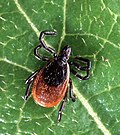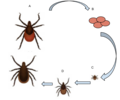Ixodes scapularis
Ixodes scapularis is a species of tick that is commonly known as the deer tick or black-legged tick. It is a significant vector of several diseases, including Lyme disease, anaplasmosis, and babesiosis.
Taxonomy[edit]
Ixodes scapularis belongs to the Ixodidae family of hard ticks. It was first described by the French zoologist Jean-Baptiste Lamarck in 1801. The genus name Ixodes is derived from the Greek word ixos, meaning sticky or gluey, while scapularis refers to the tick's scapular or shoulder-like shape.
Distribution and habitat[edit]
Ixodes scapularis is widely distributed across the eastern and central United States, as well as parts of Canada. It inhabits wooded and grassy areas, particularly those populated by its preferred host, the white-tailed deer.
Life cycle[edit]
The life cycle of Ixodes scapularis consists of four stages: egg, larva, nymph, and adult. The tick requires a blood meal at each stage after hatching, with different hosts typically used at each stage.
Disease transmission[edit]
Ixodes scapularis is a primary vector of several significant diseases. It is perhaps best known for transmitting Borrelia burgdorferi, the bacterium that causes Lyme disease. It can also transmit Anaplasma phagocytophilum, which causes anaplasmosis, and Babesia microti, which causes babesiosis.
Prevention and control[edit]
Prevention of tick bites is the primary method of controlling the diseases transmitted by Ixodes scapularis. This can be achieved through the use of insect repellents, wearing long clothing, and performing regular tick checks after being in tick-infested areas.
Ixodes scapularis[edit]
-
Adult deer tick
-
Deer tick Ixodes scapularis
-
Deer tick life cycle
-
Ixodes scapularis
-
Deer ticks illustration
-
Engorged Ixodes scapularis
Ad. Transform your life with W8MD's Budget GLP-1 injections from $75


W8MD offers a medical weight loss program to lose weight in Philadelphia. Our physician-supervised medical weight loss provides:
- Weight loss injections in NYC (generic and brand names):
- Zepbound / Mounjaro, Wegovy / Ozempic, Saxenda
- Most insurances accepted or discounted self-pay rates. We will obtain insurance prior authorizations if needed.
- Generic GLP1 weight loss injections from $75 for the starting dose.
- Also offer prescription weight loss medications including Phentermine, Qsymia, Diethylpropion, Contrave etc.
NYC weight loss doctor appointmentsNYC weight loss doctor appointments
Start your NYC weight loss journey today at our NYC medical weight loss and Philadelphia medical weight loss clinics.
- Call 718-946-5500 to lose weight in NYC or for medical weight loss in Philadelphia 215-676-2334.
- Tags:NYC medical weight loss, Philadelphia lose weight Zepbound NYC, Budget GLP1 weight loss injections, Wegovy Philadelphia, Wegovy NYC, Philadelphia medical weight loss, Brookly weight loss and Wegovy NYC
|
WikiMD's Wellness Encyclopedia |
| Let Food Be Thy Medicine Medicine Thy Food - Hippocrates |
Medical Disclaimer: WikiMD is not a substitute for professional medical advice. The information on WikiMD is provided as an information resource only, may be incorrect, outdated or misleading, and is not to be used or relied on for any diagnostic or treatment purposes. Please consult your health care provider before making any healthcare decisions or for guidance about a specific medical condition. WikiMD expressly disclaims responsibility, and shall have no liability, for any damages, loss, injury, or liability whatsoever suffered as a result of your reliance on the information contained in this site. By visiting this site you agree to the foregoing terms and conditions, which may from time to time be changed or supplemented by WikiMD. If you do not agree to the foregoing terms and conditions, you should not enter or use this site. See full disclaimer.
Credits:Most images are courtesy of Wikimedia commons, and templates, categories Wikipedia, licensed under CC BY SA or similar.
Translate this page: - East Asian
中文,
日本,
한국어,
South Asian
हिन्दी,
தமிழ்,
తెలుగు,
Urdu,
ಕನ್ನಡ,
Southeast Asian
Indonesian,
Vietnamese,
Thai,
မြန်မာဘာသာ,
বাংলা
European
español,
Deutsch,
français,
Greek,
português do Brasil,
polski,
română,
русский,
Nederlands,
norsk,
svenska,
suomi,
Italian
Middle Eastern & African
عربى,
Turkish,
Persian,
Hebrew,
Afrikaans,
isiZulu,
Kiswahili,
Other
Bulgarian,
Hungarian,
Czech,
Swedish,
മലയാളം,
मराठी,
ਪੰਜਾਬੀ,
ગુજરાતી,
Portuguese,
Ukrainian






